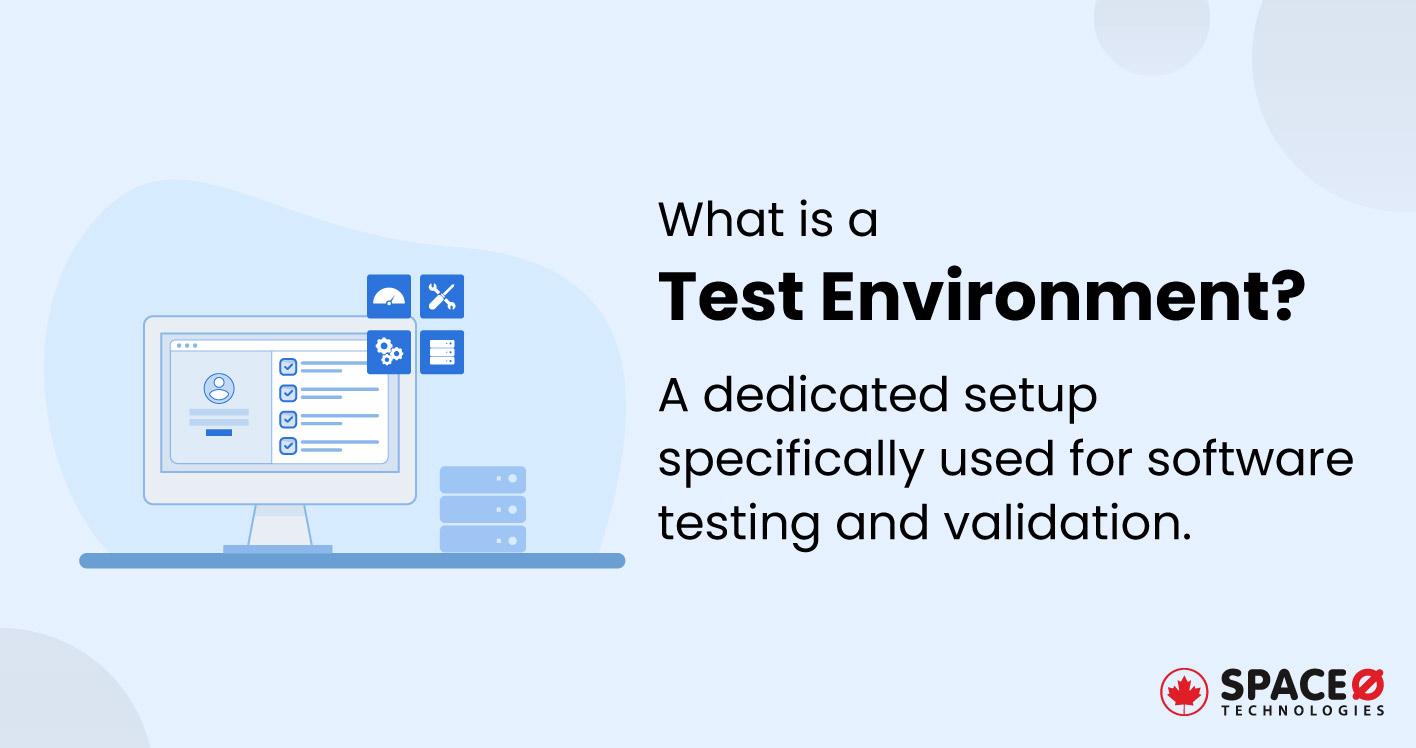
What is a Test Environment? [Definition Simple Explained]
Table of Contents
What is a Test Environment?
A test environment is a specialized setup where software functionalities are tested to check whether they meet the predefined requirements or not.
A test environment is made up of various components like hardware, software, configurations, and data that are set up to replicate the behavior of an actual production environment.
A test environment is also known as a test bed. In addition, for conducting comprehensive testing, a test environment plays an important role throughout the software testing life cycle.
The software testing life cycle is an in-depth process that helps and guides you to conduct testing of a software solution from start to end. If you want to learn in detail about the software testing process, read our guide on the software testing life cycle (STLC).
The purpose of a test environment is to rectify and fix issues in a specialized setup to ensure that the software meets the predefined standards of performance, security, compatibility, and reliability.
5 Key Components of the Test Environment
If you want to set up a test environment, here are 5 key components to consider.
Hardware Resources to Set up a Testing Environment
For setting up a testing environment, you need certain hardware resources which are storage devices, computers, network equipment, and servers. These components play an important role to create a physical infrastructure to run a software application and simulate it under real-world conditions.
Programs, Software, Testing Tools, and Frameworks
How do you perform testing? The answer is you need to install the necessary operating systems, databases, middleware, and frameworks on which the software application relies. The versions of these installed software and programs should match the production version.
Moreover, you also need software testing frameworks, tools, database software, automated software, and a test harness. A test harness is a collection of software and test data configured to test a program unit by running it under varying conditions. Explore our short article on a test harness, its benefits, and its importance in software testing.
These are the important tools that help you to verify the security, performance, usability, and scalability of software applications in similar environments like production.
Combination of the Right Network Tools for Connectivity
To carry out effective testing, you need to set up networking components like firewalls, load balancers, and routers to simulate the production environment. In addition, you also need to configure the security of the testing environment for unauthorized access.
Prepare Realistic and Comprehensive Test Data
You need collective test data for conducting adequate testing of a software application. For that, you have to analyze the application’s functional and non-functional requirements to know what type of data would be needed for testing. Your test data should be a close replica of production data.
So, it becomes easy to test the software in various conditions and ensure the software works perfectly well when deployed.
Creating a Detailed Document for Conducting Testing
To perform detailed and accurate testing of software, you should prepare a complete software testing strategy. In such a case, creating detailed documentation on the test environment setup, test cases, test plans, test results, and configuration guidelines helps to carry out appropriate testing.
Also, having testing documentation helps to reduce costs associated with fixing problems later in the development lifecycle.
5 Benefits of a Test Environment
- Improved quality: With a test environment, you can perform testing of the software under various scenarios and conditions to identify and resolve issues or bugs. So, you can release the software into production by ensuring good quality and reliability.
- Risk mitigation: By testing in a controlled and isolated environment, you can reduce the risk of introducing problems into the production environment. This ensures that the final product meets the desired quality standards and requirements.
- Cost savings: A test environment can help to reduce the costs associated with fixing problems later in the development lifecycle. This is because a test environment helps you to identify and resolve the errors within each testing phase which can be expensive later when the software is deployed.
- Faster time-to-market: With a well-designed test environment, you can speed up the testing process, allowing for faster time-to-market for the final product.
- Flexibility: A test environment allows for testing in various configurations and scenarios, which can be difficult or impossible to replicate in a production environment.
4 Different Types of Testing Environments
Here are the 4 core types of test environments.
- Development environment: Developers and programmers use the development environment to write and modify the code. This environment is not suitable for testing purposes as it is not created exactly like the production environment.
- Testing environment: Software testers create a specified environment for testing and verify that the software functionalities perform well and meet the expected quality standards and requirements. In most cases, a testing environment is an exact copy of the production environment.
- Staging environment: When software testers want to test the software under production-lie conditions by simulating real-world scenarios and real data. The staging environment is used as a pre-production environment to identify any issues or bugs before releasing the software to the public.
- Production environment: This is the live environment where the software is deployed for end-users. This environment is the final destination for the software after it has been developed, tested, and released.
The other types of testing environments are a performance testing environment, security testing environment, chaos testing environment, and integration testing environment.
In summary, test environments enable thorough software testing to verify the quality, functionality, and reliability of the software. With this setup, it becomes easy to mitigate risks and reduce costs associated with fixing issues later in the development lifecycle. It is a critical component for delivering high-quality software with faster time-to-market.
All our projects are secured by NDA
100% Secure. Zero Spam
*All your data will remain strictly confidential.
Trusted by


Bashar Anabtawi
Canada
“I was mostly happy with the high level of experience and professionalism of the various teams that worked on my project. Not only they clearly understood my exact technical requirements but even suggested better ways in doing them. The Communication tools that were used were excellent and easy. And finally and most importantly, the interaction, follow up and support from the top management was great. Space-O not delivered a high quality product but exceeded my expectations! I would definitely hire them again for future jobs!”

Canada Office
2 County Court Blvd., Suite 400,
Brampton, Ontario L6W 3W8
Phone: +1 (437) 488-7337
Email: sales@spaceo.ca



